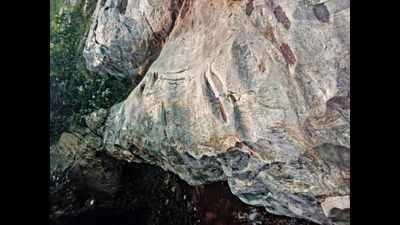- News
- City News
- chennai News
- Neolithic grooves found in Krishnagiri district
Trending
This story is from February 21, 2021
Neolithic grooves found in Krishnagiri district
Prehistoric grooves used by early Neolithic people to sharpen stone axes have been found at Kundhukottai, 13km from Denkanikottai in Krishnagiri district, a place known for several previous Neolithic discoveries. Members of Krishnagiri District Historical Research Centre, Suresh and Anbarasu, have identified the grooves. Experts, who later confirmed the discovery, said the grooves may be more than 5,000 years old.

The grooves were used by early Neolithic people to sharpen stone axes
CHENNAI: Prehistoric grooves used by early Neolithic people to sharpen stone axes have been found at Kundhukottai, 13km from Denkanikottai in Krishnagiri district, a place known for several previous Neolithic discoveries. Members of Krishnagiri District Historical Research Centre, Suresh and Anbarasu, have identified the grooves. Experts, who later confirmed the discovery, said the grooves may be more than 5,000 years old.
Memorial and hero stone expert Sugavana Murugan, who have visited the site, said, “We have discovered16 grooves used by Neolithic people to sharpen stone axes and other tools.The approximate length of the grooves was 15-20cm, and width 5-8cm,” he said.
For Suresh and Anbarasu, who first noticed the grooves, it was a hectic trek towards the interior of Kundukottai. The site is close to the popular Yaanaipallam falls. "The place is also significant as British writer and hunter Kenneth Anderson used to trek the hills in the region. Anderson has mentioned the place in his book, ‘The Black Panther of Sivanipalli’,” said Murugan.
The Neolithic period (6,000 BC to 2,000BC) is considered the fag end of the Stone Age. Neolithic stone tools have been found in Kundhukottai and the Yaanaipallam falls, where these tools are worshipped by locals in the nearby Jalaveerabthirar temple and other temples. “The place is inhabited by people since the Neolithic ages. Pottery, dating back to the Neolithic period and Iron Age, is also found here. It shows there was continuous human habitation in the region,” said Murugan.
Memorial and hero stone expert Sugavana Murugan, who have visited the site, said, “We have discovered16 grooves used by Neolithic people to sharpen stone axes and other tools.The approximate length of the grooves was 15-20cm, and width 5-8cm,” he said.
For Suresh and Anbarasu, who first noticed the grooves, it was a hectic trek towards the interior of Kundukottai. The site is close to the popular Yaanaipallam falls. "The place is also significant as British writer and hunter Kenneth Anderson used to trek the hills in the region. Anderson has mentioned the place in his book, ‘The Black Panther of Sivanipalli’,” said Murugan.
The Neolithic period (6,000 BC to 2,000BC) is considered the fag end of the Stone Age. Neolithic stone tools have been found in Kundhukottai and the Yaanaipallam falls, where these tools are worshipped by locals in the nearby Jalaveerabthirar temple and other temples. “The place is inhabited by people since the Neolithic ages. Pottery, dating back to the Neolithic period and Iron Age, is also found here. It shows there was continuous human habitation in the region,” said Murugan.
End of Article
FOLLOW US ON SOCIAL MEDIA










